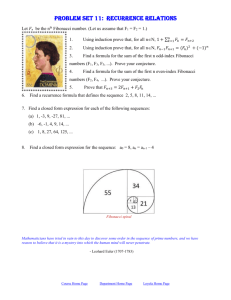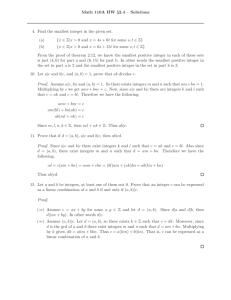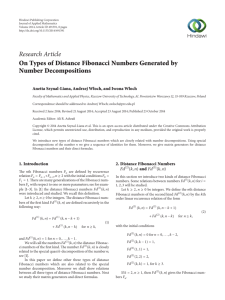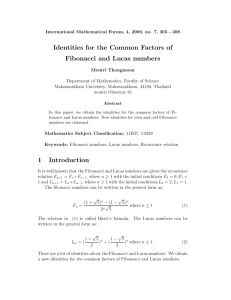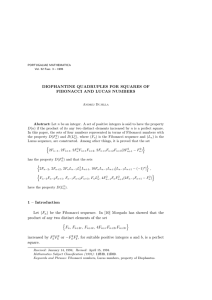Homework Solution 12, Winter 2008
advertisement
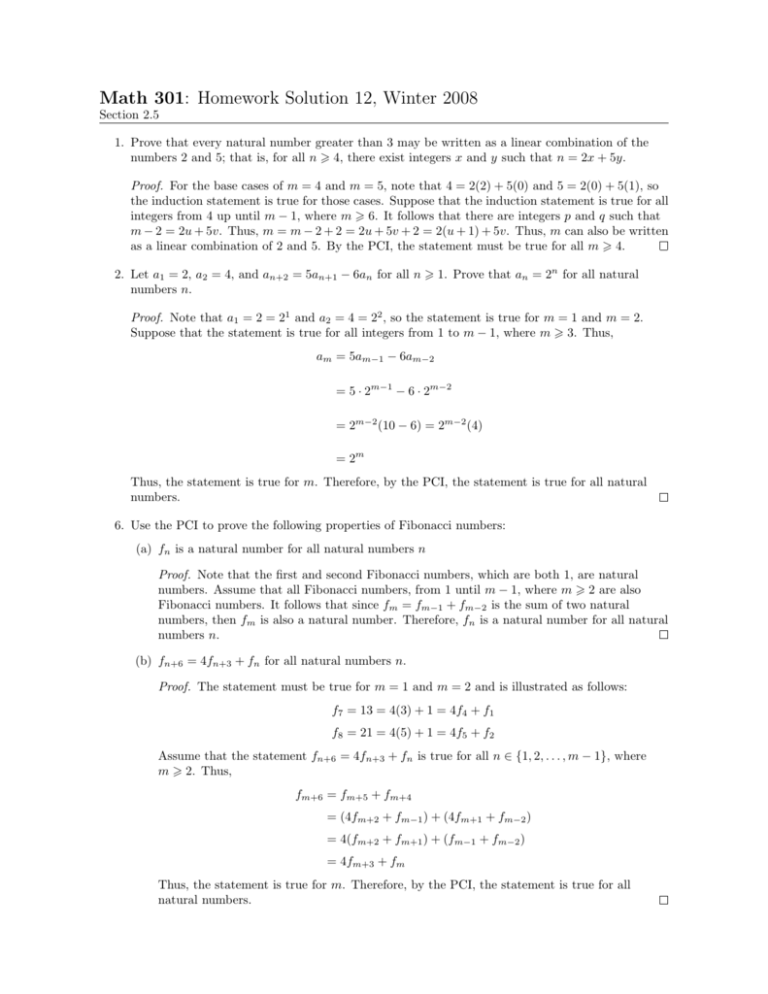
Math 301: Homework Solution 12, Winter 2008
Section 2.5
1. Prove that every natural number greater than 3 may be written as a linear combination of the
numbers 2 and 5; that is, for all n > 4, there exist integers x and y such that n = 2x + 5y.
Proof. For the base cases of m = 4 and m = 5, note that 4 = 2(2) + 5(0) and 5 = 2(0) + 5(1), so
the induction statement is true for those cases. Suppose that the induction statement is true for all
integers from 4 up until m − 1, where m > 6. It follows that there are integers p and q such that
m − 2 = 2u + 5v. Thus, m = m − 2 + 2 = 2u + 5v + 2 = 2(u + 1) + 5v. Thus, m can also be written
as a linear combination of 2 and 5. By the PCI, the statement must be true for all m > 4.
2. Let a1 = 2, a2 = 4, and an+2 = 5an+1 − 6an for all n > 1. Prove that an = 2n for all natural
numbers n.
Proof. Note that a1 = 2 = 21 and a2 = 4 = 22 , so the statement is true for m = 1 and m = 2.
Suppose that the statement is true for all integers from 1 to m − 1, where m > 3. Thus,
am = 5am−1 − 6am−2
= 5 · 2m−1 − 6 · 2m−2
= 2m−2 (10 − 6) = 2m−2 (4)
= 2m
Thus, the statement is true for m. Therefore, by the PCI, the statement is true for all natural
numbers.
6. Use the PCI to prove the following properties of Fibonacci numbers:
(a) fn is a natural number for all natural numbers n
Proof. Note that the first and second Fibonacci numbers, which are both 1, are natural
numbers. Assume that all Fibonacci numbers, from 1 until m − 1, where m > 2 are also
Fibonacci numbers. It follows that since fm = fm−1 + fm−2 is the sum of two natural
numbers, then fm is also a natural number. Therefore, fn is a natural number for all natural
numbers n.
(b) fn+6 = 4fn+3 + fn for all natural numbers n.
Proof. The statement must be true for m = 1 and m = 2 and is illustrated as follows:
f7 = 13 = 4(3) + 1 = 4f4 + f1
f8 = 21 = 4(5) + 1 = 4f5 + f2
Assume that the statement fn+6 = 4fn+3 + fn is true for all n ∈ {1, 2, . . . , m − 1}, where
m > 2. Thus,
fm+6 = fm+5 + fm+4
= (4fm+2 + fm−1 ) + (4fm+1 + fm−2 )
= 4(fm+2 + fm+1 ) + (fm−1 + fm−2 )
= 4fm+3 + fm
Thus, the statement is true for m. Therefore, by the PCI, the statement is true for all
natural numbers.
Homework Solution 12, page 2
(c) For any natural number a, fa fn + fa+1 fn+1 = fa+n+1 for all natural numbers n.
Proof. Let a be a fixed natural number. Notice that the statement is true for n = 1 since
fa f1 + fa+1 f2 = fa + fa+1 = fa+2 = f1+n+1 .
Similarly,
fa f2 + fa+1 f3 = fa + 2fa+1 = fa + fa+1 + fa+1 = fa+2 + fa+1 = fa+3 = f2+n+1 .
Thus, the statement is true for the cases of n = 1 and n = 2. Assume that the statement is
true for n ∈ {1, 2, · · · , m − 1}, where m > 3. It follows that
fa fm + fa+1 fm+1 = fa (fm−1 + fm−2 ) + fa+1 (fm + fm−1 )
= fa fm−1 + fa fm−2 + fa+1 fm + fa+1 fm−1
= fa fm−1 + fa+1 fm + fa fm−2 + fa+1 fm−1
|
{z
} |
{z
}
fa+m
fa+m−1
= fa+m + fa+m−1
= fa+m+1
Thus, the statement is also true for m. Therefore, by the PCI, the statement is true for all
natural numbers.
(d) (Binet’s formula). Let α be the positive solution √
and β be the negative
√ solution to the
equation x2 = x + 1. (The values are α = 21 (1 + 5) and β = 12 (1 − 5).) Show for all
natural numbers n that
αn − β n
fn =
α−β
Proof. Note that the statement is true for n = 1 and n = 2 since
f1 = 1 =
α1 − β 1
α−β
f2 = 1 =
(α + 1) − (β + 1)
α2 − β 2
α−β
=
=
α−β
α−β
α−β
Assume the statement is true for all n ∈ {1, 2, · · · , m − 1}. Thus,
fm = fm−1 + fm−2
=
αm−1 − β m−1
αm−2 − β m−2
+
α−β
α−β
=
αm−2 (α + 1) − β m−2 (β + 1)
α−β
=
αm−2 (α2 ) − β m−2 (β 2 )
α−β
=
αm − β m
α−β
Thus, the statement is also true for m. Therefore, the statement, fn =
natural numbers n.
αn −β n
α−β ,
is true for all

